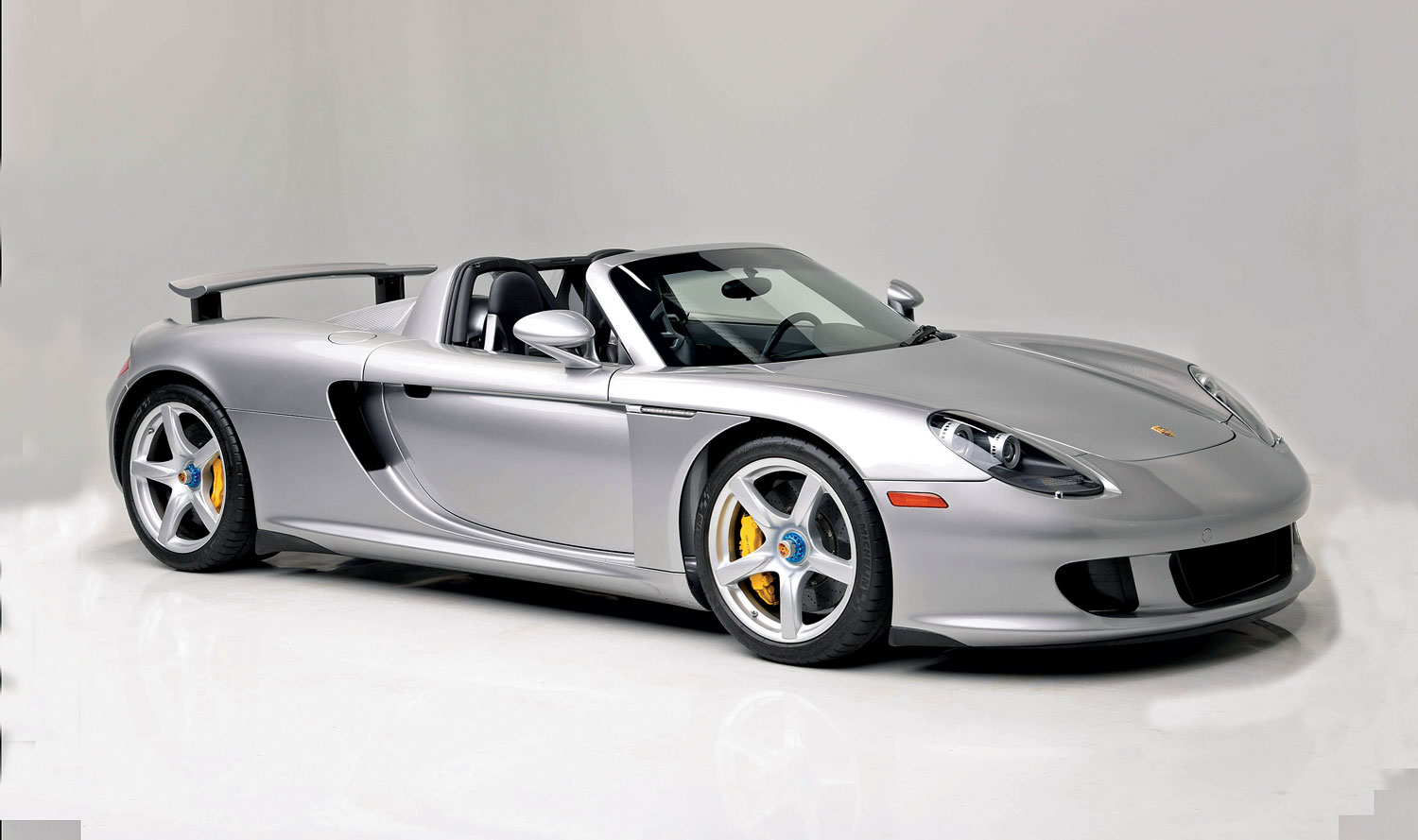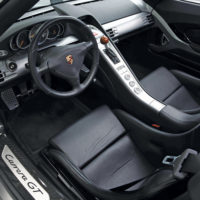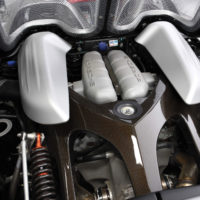SCM Analysis
Detailing
| Vehicle: | 2004 Porsche Carrera GT |
| Years Produced: | 2004–06 |
| Number Produced: | 1,270 |
| SCM Valuation: | $780,500 |
| Tune Up Cost: | $3,000 for tune-up; $10,000 for major service |
| Chassis Number Location: | Driver’s side B-pillar door jamb, tag in truck under covering, tag at base of windshield |
| Engine Number Location: | Driver’s side, at back of engine on bell housing facing up |
| Club Info: | Porsche Club of America |
| Website: | http://www.pca.org |
| Alternatives: | 1994–98 McLaren F1, 2002–03 Ferrari Enzo, 2004–05 Maserati MC12 |
| Investment Grade: | B |
This car, Lot 1398, sold for $1,980,000, including buyer’s premium, at Barrett-Jackson’s Scottsdale, AZ, auction, on January 23, 2022.
The 2004–06 Carrera GTs were intriguing at introduction, but at $450k each, they did not immediately sell out. Nor did they appreciate in value. In 2011 you could have purchased a fully serviced, 4,000-mile 2004 model for $300,000. A mint, paint-to-sample 2005 model was $400,000. So how did the market get to $2m a decade later?
Let’s review. The Carrera GT was the third in a line of Porsche’s exotic-construction street supercars inspired by race-car technology.
The first was the 1987–88 Porsche 959 (see German Profile, March 2022, p. 54). Advanced for its day, the 959 featured a 444-hp twin-turbocharged flat 6-cylinder engine with bodywork made from aluminum and carbon fiber plus a computer-managed suspension. Built in just 338 examples, it was hugely desirable when introduced and is even more so today.
The 959 was followed by the 1996–98 GT1. Initially built as a race car, it won Le Mans in 1998. Porsche produced 22 street models for homologation purposes. The GT1 used a development of the competition Type 962 engine with 544 horsepower. The street versions sell for approximately $13m to $15m today — if you can find one for sale.
A racer for the road
Having withdrawn from world-class racing in 1998, Porsche was left with a fully developed race car intended for Le Mans, the LMP 2000. Porsche motorsports chief Norbert Singer was worried about losing his racing engineers to other German automobile firms. To keep that team working and happy, Porsche moved the orphaned racing technology to development of a new street car, the Carrera GT.
At that time, Porsche was also busy working on its first SUV, the Cayenne. Corporate finances were strained by the effort. Ultimately, Porsche believed (correctly, as it turned out) in its strong sales forecast for the Cayenne, and, despite misgivings, also financed the Carrera GT project.
The mid-engine 2-seater adopted a V10 engine designed originally for the ill-fated Footwork Formula One race car. It displaced 5,733 cc in an unusual 68-degree format with dual-overhead cams and four valves per cylinder. It had an aluminum block with Nikasil-coated cylinder bores, titanium connecting rods and a Bosch fuel-management system. With a redline of 8,400 rpm, the engine developed 605 horsepower and 435 foot-pounds of torque.
Porsche used a 6-speed manual gearbox, not an automatic. (This important element contributes to the current desirability of the car.) The clutch was pure race-issue, self-engaging multiple 6.5-inch discs that required some experience to operate smoothly. The suspension was inboard with horizontal coil-over shocks activated through pushrods and rocker arms. Porsche employed large 15-inch ceramic brakes with six-piston calipers working through forged magnesium center-lock wheels, 19-inch-by-9.5-inch in front and 20-inch-by-12.5-inch in back.
World-class performance
Italy’s A.T.R. Group built the carbon-fiber monocoque. The body used over a thousand pieces of resin cloth, autoclave-bonded by heat and pressure. However, Porschephiles considered the novel exterior design to be ungainly, especially in sideview.
The Carrera GT was not a lightweight, track-oriented car. Although at 3,150 pounds it was not heavy, it was outfitted like a luxury car. Standard equipment included a removable Targa-style top, full leather interior, luggage set, radio and navigation and air conditioning. Despite being “loaded,” the Carrera GT delivered an advantageous 5.7 pounds per horsepower.
Car and Driver reported performance numbers of 0–60 mph in 3.5 seconds, 0–100 mph in 6.8 seconds, and a top speed of 205 mph. The quarter-mile run came up in 11.2 seconds with a final speed of 132 mph. That was comparable to Ferrari’s Enzo, but the Porsche’s handling and brakes were superior, demonstrated by its better slalom and skid-pad results. Also, the Enzo was $200,000 more expensive and, with its automatic gearbox, not as engaging to drive.
From flop to flavor of the month
Porsche originally planned to produce 1,500 Carrera GTs. Its dealers worked diligently to sell the cars with phone calls, invitations to test drive, deals and promises of preferential status for future exotics. Porsche extended production past 2004 into 2005 and then 2006.
Initially, the car came in six colors: GT Silver, Seal Gray, Basalt Black, black (non-metallic), Guards Red, and Fayence Yellow. After 2004, Porsche added special orders and paint-to-sample availability and those cars are more highly prized today.
Ultimately, Porsche built 1,270 Carrera GTs, with 675 examples coming to North America (644 to the U.S. and 31 to Canada). Obviously, Porsche had an over-optimistic sales forecast for the Carrera GT.
There was a price bump for early deliveries, but soon afterwards, depreciation set in. Price declines continued for about a decade, then reversed. That reversal is not an unusual occurrence for Porsche limited-production models — witness the recent price spurts for 2011 GT2 RS and 997.1 and 997.2 GT3 RS models. By 2015, a few Carrera GTs had brought $1,000,000, spurred by the introduction of the 887-hp 918 Spyder with its hybrid power, automatic gearbox and electronic drivers’ aids.
Suddenly, the more-mechanical Carrera GT looked attractive. Further, some 918 buyers wanted the earlier Porsche supercars — the 959, GT1 and Carrera GT — to collect the full run. But that value bulge soon subsided, with prices softening to around $750,000.
By 2018, prices were again rising, and then came the pandemic price boom that affected the whole market. Quickly, Carrera GTs doubled in price. In January 2022, Bring a Trailer sold one for $1,907,000 and then a second one for $2,005,000. A low-mileage example in paint-to-sample blue, green, or orange might get $2,500,000 today.
Right on target
Our Barrett-Jackson Carrera GT benefited from having just 1,257 miles, one owner from new, and complete service records. But buyers today are picky, and it takes a unique car to set new records. Our subject car was painted in the most common color, GT Silver, and it also had the most common gray interior. At $1,980,000 it sold right where it should have — in line with those recent online sales. Call it a fair deal in this seller’s market. ♦
(Introductory description courtesy of Barrett-Jackson.)



